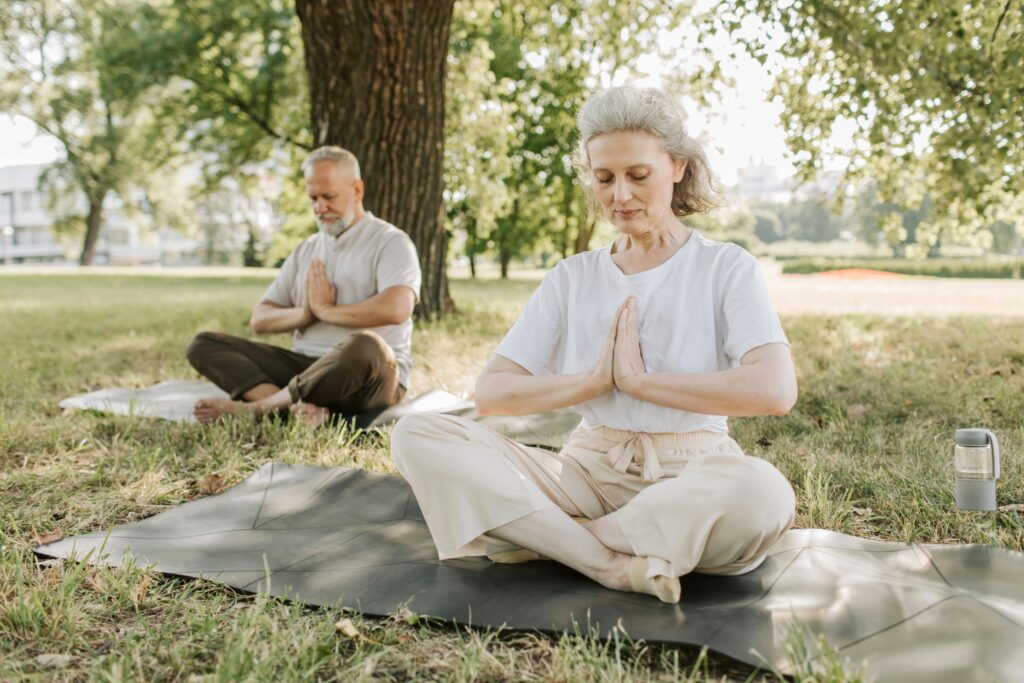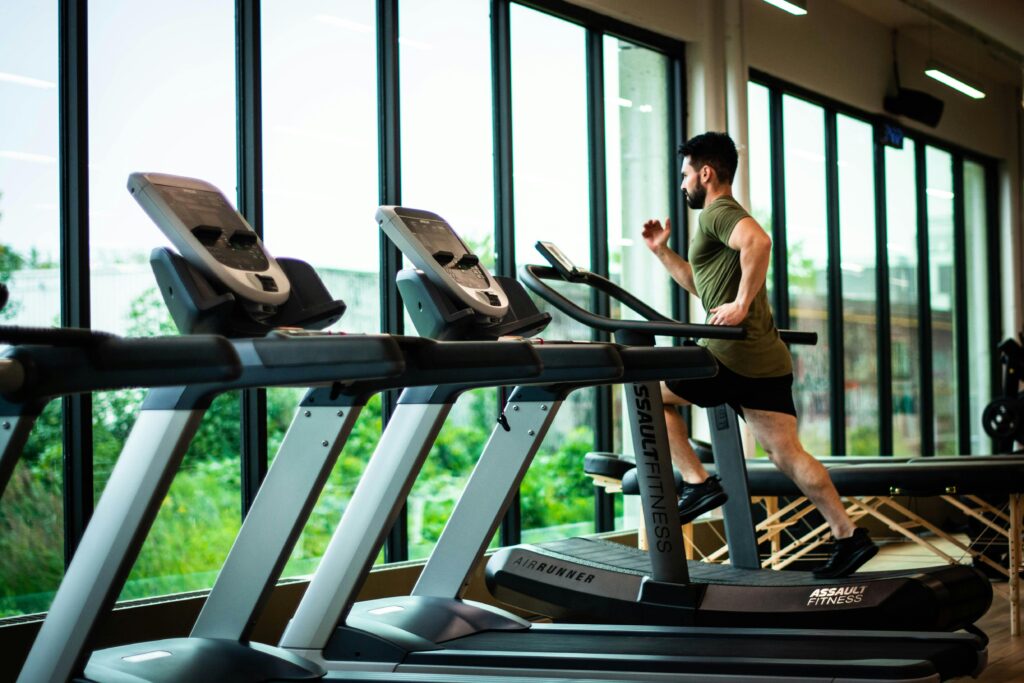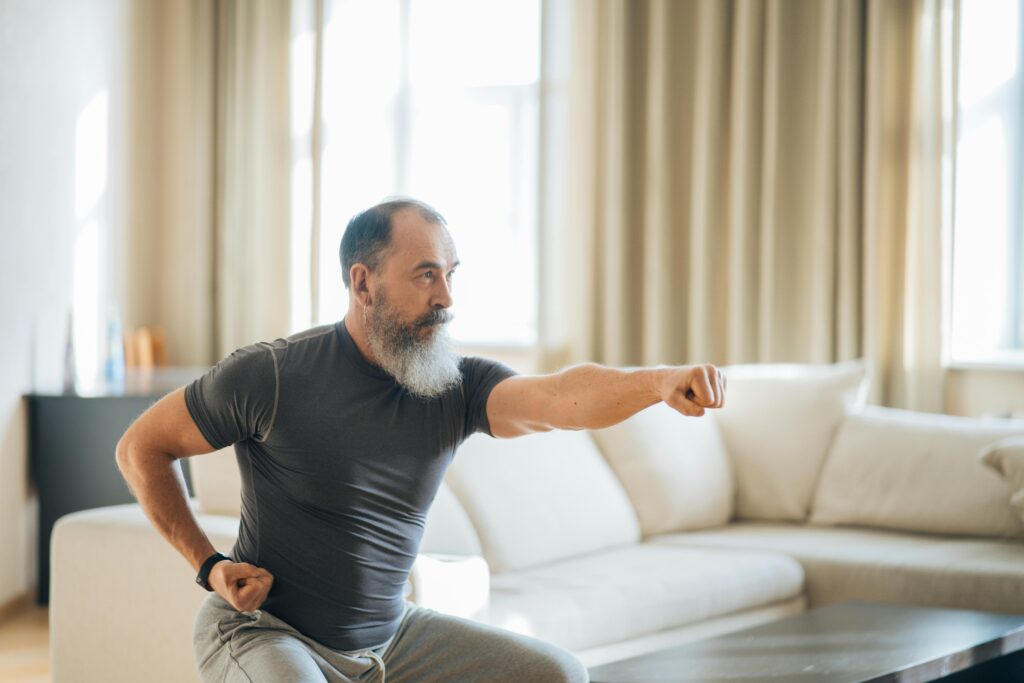Stretching Exercises for Seniors

Introduction:
Unlocking the Fountain of Vitality for Stretching Exercises for Seniors
Aging gracefully is an art, and at the heart of this artistic journey lies the key to mobility, flexibility, and overall well-being—stretching exercises for seniors. In this comprehensive guide, we embark on a transformative exploration of the profound impact that targeted stretches can have on the lives of our cherished seniors.
1. The Essence of Flexibility: As the years gracefully unfold, maintaining and enhancing flexibility becomes paramount. Stretching Exercises for Seniors emerge as a holistic solution, offering a path that not only enhances physical capabilities but also nurtures mental resilience.
2. A Fountain of Youth: Stretching Exercises for Seniors is often hailed as the fountain of youth for good reason. It holds the power to reverse the tightening effects of time, fostering increased flexibility in muscles and joints. This, in turn, empowers seniors to embrace life with vitality, engage in daily activities effortlessly, and revel in the joys of an active lifestyle.
3. The Benefits Beyond the Physical: While the physical advantages of Stretching Exercises for Seniors are profound, the ripple effects extend far beyond. By engaging in regular stretching routines, seniors embark on a journey that mitigates stress, enhances mental clarity, and instills a sense of balance and calm—an indispensable arsenal for navigating the complexities of life’s later chapters.
4. Tailored to Senior Needs: Understanding the unique needs and considerations of seniors, our guide navigates through Stretching Exercises for Seniors specifically designed for this demographic. From gentle yoga-inspired stretches to targeted joint mobility exercises, each routine is curated to meet the diverse needs of seniors at various fitness levels.
5. Empowering Independence: Flexibility is synonymous with independence, and by embracing stretching exercises, seniors reclaim and fortify their autonomy. Enhanced range of motion translates to increased ease in performing daily tasks, reducing reliance on external assistance, and fostering a sense of empowerment.
6. The Mind-Body Connection: The intricate dance between body and mind is a central theme in the world of Stretching Exercises for Seniors. As seniors commit to these routines, they embark on a journey that nurtures mental resilience, cultivates mindfulness, and celebrates the profound connection between physical well-being and mental harmony.
7. A Journey for Every Senior: Whether a seasoned fitness enthusiast or someone taking their first steps into the world of Stretching Exercises for Seniors, this guide accommodates every senior. It’s an inclusive journey that acknowledges diverse starting points, embraces personal progress, and encourages individuals to savor the transformative effects at their own pace.
Join us in unraveling the secrets of Stretching Exercises for Seniors —a journey that transcends physical routines and becomes a celebration of life, vitality, and the art of aging gracefully. Let’s embark on this transformative odyssey, where each stretch is a step towards unlocking the fountain of vitality and embracing the golden years with boundless energy and resilience.

The Significance of Extending for Seniors:
Battle Solidity: Firm joints and muscles are normal difficulties for seniors, frequently prompting diminished versatility. Standard extending helps battle solidity by advancing blood flow and expanding the adaptability of muscles and joints.
Further develop Adaptability: Maturing can prompt a characteristic decrease in adaptability. Extending practices target explicit muscle gatherings, upgrading their versatility and scope of movement. This, thusly, adds to a further developed stance and equilibrium.
Help Versatility: Keeping up with ideal portability is fundamental for performing everyday exercises easily. Extending practices for Stretching Exercises for Seniors center around upgrading the development of joints, guaranteeing seniors can explore their environmental elements easily.
Forestall Wounds: Tight muscles and decreased adaptability can increase the risk of wounds, especially in more established adults. Integrating extending into an everyday schedule forestalls wounds by advancing better joint wellbeing and lessening muscle strain.
The 20-Minute Extending Schedule:
Neck Stretches (2 minutes): Tenderly slant your head from one side to another, forward and in reverse. Stand firm on each footing for 15–30 seconds to deliver strain to the neck.
Shoulder Rolls (2 minutes): Pivot your shoulders in a roundabout movement, both clockwise and counterclockwise. This reduces pressure on the upper back and shoulders.
Arm and Wrist Adaptability (3 minutes): Broaden your arms, pivoting your wrists in the two headings. Stretching Exercises for Seniorseach arm across your chest, holding for 15–30 seconds, to further develop adaptability.
Spinal Turn (3 minutes): Situated or standing, contort your chest area tenderly to each side. This exercise advances adaptability in the spine and reduces lower back distress.
Hip Flexor Stretch (3 minutes): While situated, expand one leg and bring the opposite foot toward the inward thigh. Incline forward, coming to your toes to extend the hip flexors and hamstrings.
Quadriceps Stretch (2 minutes): While standing, bring one foot towards your rump, holding the lower leg. This stretches the quadriceps and further develops balance.
Calf Stretches (2 minutes): Stand confronting a wall, putting your hands on it. Stage one foot back and press the impact point into the floor, extending the lower leg muscles.
Lower leg circles (2 minutes): Sit serenely and lift one foot off the ground, surrounding your lower leg in the two bearings. This exercise advances lower leg adaptability.

Conclusion: Embracing Flexibility and Vitality in Seniors
As we conclude our exploration of stretching exercises for seniors, it’s evident that flexibility holds the key to unlocking a realm of physical and mental well-being. The significance of incorporating regular stretching routines into the lives of seniors cannot be overstated.
1. Enhancing Range of Motion: Stretching exercises empower seniors to expand their range of motion, promoting increased flexibility in joints and muscles. This enhanced mobility not only aids in daily activities but also contributes to a more independent and active lifestyle.
2. Mitigating Joint Stiffness and Pain: One of the most tangible benefits of consistent stretching is the alleviation of joint stiffness and discomfort. Seniors often experience stiffness due to age-related changes, and targeted stretches act as a natural remedy, fostering joint health and reducing pain.
3. Improved Posture and Balance: Stretching plays a pivotal role in correcting and maintaining good posture. As seniors engage in stretches that target various muscle groups, they fortify their core and improve balance, reducing the risk of falls and enhancing overall stability.
4. Stress Reduction and Mental Well-Being: The mind-body connection is a cornerstone of successful aging, and stretching exercises provide a conduit for stress reduction. Gentle stretches release tension, promote relaxation, and contribute to mental well-being, fostering a positive outlook on life.
5. Tailoring Exercises to Individual Needs: The versatility of stretching exercises allows for a personalized approach. Seniors can tailor their routines to address specific areas of concern or accommodate varying levels of fitness. This adaptability ensures that everyone, regardless of their starting point, can embark on a journey towards improved flexibility.
6. Incorporating Stretching into Daily Rituals: Encouraging seniors to weave stretching exercises into their daily rituals transforms these routines into habits. Whether it’s a morning stretch to kickstart the day or gentle stretches before bedtime, establishing a consistent practice ensures lasting benefits.
7. Fostering Social Connection: Engaging in group stretching sessions fosters social connection and a sense of community among seniors. Shared experiences create a supportive environment, motivating individuals to stay committed to their stretching routines and enjoy the journey together.
8. Professional Guidance and Safety: For those new to stretching or with specific health concerns, seeking professional guidance ensures safety and effectiveness. Physical therapists or fitness instructors specializing in senior wellness can tailor stretching routines to individual needs, providing valuable support on the path to improved flexibility.
In conclusion, the journey of incorporating stretching exercises into the lives of seniors transcends physical benefits. It’s about embracing a holistic approach to aging—one that prioritizes flexibility, vitality, and overall well-being. As seniors commit to regular stretching, they not only enhance their physical capabilities but also cultivate a positive and empowered mindset, savoring the joys of an active and fulfilling senior lifestyle. Embrace the stretch, celebrate the flexibility, and revel in the vibrant vitality that awaits on this transformative journey.

FAQs for Stretching Exercises for Seniors
1. Why are stretching exercises important for seniors?
- Stretching enhances flexibility, improves joint mobility, and contributes to overall well-being, aiding seniors in daily activities.
2. Can seniors with limited mobility benefit from stretching?
- Absolutely. Gentle stretches tailored to individual abilities can enhance range of motion and improve comfort for seniors with limited mobility.
3. How often should seniors engage in stretching exercises?
- Aim for at least 2-3 days a week, but consistency is key. Regular, gentle stretching routines yield optimal benefits for seniors.
4. Are there specific stretches for seniors with joint issues?
- Yes, modified stretches and low-impact exercises can be beneficial. Consult with a healthcare professional for personalized guidance.
5. Can stretching exercises help alleviate arthritis discomfort?
- Yes, certain stretches can help manage arthritis symptoms by improving joint flexibility and reducing stiffness.
6. Are there safety considerations for seniors starting a stretching routine?
- Always consult with a healthcare provider before starting any exercise program. Start gently and listen to your body to avoid overexertion.
7. Can seniors perform stretching exercises at home without equipment?
- Absolutely. Many effective stretches require no equipment. Household items like chairs or walls can be used for support.
8. Are there specific stretches beneficial for balance improvement?
- Yes, incorporating balance-focused stretches, such as heel-to-toe walking or single-leg stands, can enhance stability and reduce the risk of falls.
9. Is it advisable for seniors with chronic conditions to stretch?
- In most cases, yes. Tailored stretching routines can be adapted for various health conditions, promoting flexibility and improving quality of life.
10. How long should a typical stretching session for seniors last? – Aim for 15-30 minutes per session, adjusting the duration based on individual comfort and fitness levels. Regularity is more important than duration.
Pingback: THE ANTI-INFLAMMATORY DIET FOR BEGINNERS
Your point of view caught my eye and was very interesting. Thanks. I have a question for you.
Can you be more specific about the content of your article? After reading it, I still have some doubts. Hope you can help me.
Pingback: Best Beauty Tips for Teenagers
Pingback: Best Ways to Take Rest for a Better Life
Thanks for sharing. I read many of your blog posts, cool, your blog is very good.
Your point of view caught my eye and was very interesting. Thanks. I have a question for you.
Your article helped me a lot, is there any more related content? Thanks! https://accounts.binance.com/register?ref=P9L9FQKY
Your posts always deliver quality information. Appreciate your hard work!
Can you be more specific about the content of your article? After reading it, I still have some doubts. Hope you can help me. https://www.binance.com/ro/register?ref=V3MG69RO